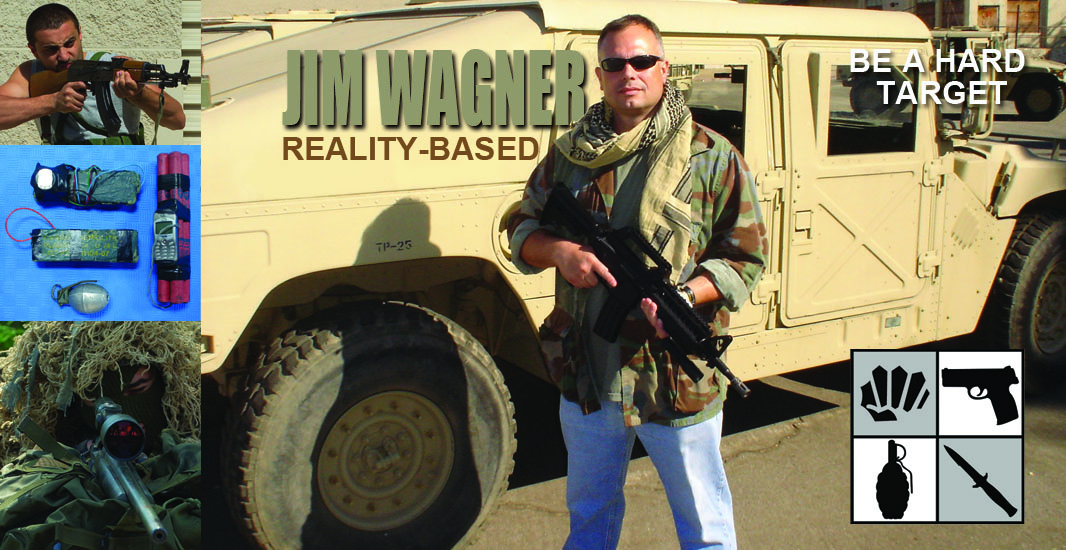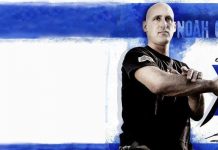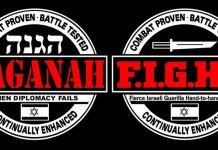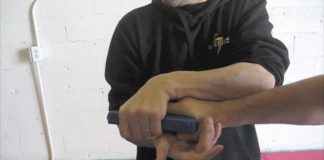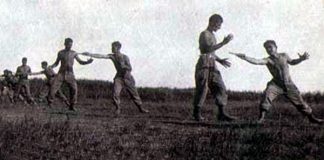Many of you who visit USAdojo.com are Krav Maga practitioners. Lately some of you may have been hearing about other Israeli martial arts systems that you never even knew existed; terms such as KAPAP, Hisardut, LOTAR, Krav Magen, and others. You may be asking yourself, do these systems even really exist, or are they fabricated to ride the successful coat tails of Krav Maga? Ever since I wrote a feature article for Black Belt magazine about the Israeli martial arts, it has created quite a stir in the Krav Maga communities.
I found this out just recently when I went on some of the chat rooms to catch up on the “chatter” about the Israeli martial arts. What I found were a lot of accusations, people upset that other Israeli martial arts were cropping up, and a lot of confusion in general. Well, since this hornet’s nest seems to have been stirred up by me, quite unexpectedly I might ad, it is obvious that I have a responsibility to shed some light on this Israeli martial arts controversy. After all, I’m the one who introduced the Israeli fighting system of KAPAP (Krav Panim l’Panim – face-to-face combat) to the United States and Canada by bringing Major Avi Nardia over here to train police and military units back in 2001 and 2002.
First of all, let me start by saying that I have trained in KAPAP, Krav Maga and Hisardut, and I myself have taught at the Wingate Institute for the Israeli Defense Forces (Bahad 8) in Netanya, Israel. This was authorized by the head of the Krav Maga Department for the IDF, Mr. “S” (I will keep his name confidential). I have also taught at the University of Tel Avi for Lt. Col. Chaim Peer (a KAPAP/Krav Maga instructor), and I have taught at the Israel Police Operational Fitness Academy at Havatselet Hasharon, Israel, authorized by Colonel Gidy Lind. I have also spent time interviewing the Who’s Who of the Israeli martial arts, in Israel, that include Dennis Hanover, Eli Avikazar, Moni Isaac, Mr. “S,” Gaby Michaeli, Moshik Keidar, and Avi Beier (he wrote the book SELF DEFENSE which was published by the Israeli Ministry of Defense ISBN 965-05-0682-9).
I found this out just recently when I went on some of the chat rooms to catch up on the “chatter” about the Israeli martial arts. What I found were a lot of accusations, people upset that other Israeli martial arts were cropping up, and a lot of confusion in general. Well, since this hornet’s nest seems to have been stirred up by me, quite unexpectedly I might ad, it is obvious that I have a responsibility to shed some light on this Israeli martial arts controversy. After all, I’m the one who introduced the Israeli fighting system of KAPAP (Krav Panim l’Panim – face-to-face combat) to the United States and Canada by bringing Major Avi Nardia over here to train police and military units back in 2001 and 2002.
First of all, let me start by saying that I have trained in KAPAP, Krav Maga and Hisardut, and I myself have taught at the Wingate Institute for the Israeli Defense Forces (Bahad 8) in Netanya, Israel. This was authorized by the head of the Krav Maga Department for the IDF, Mr. “S” (I will keep his name confidential). I have also taught at the University of Tel Avi for Lt. Col. Chaim Peer (a KAPAP/Krav Maga instructor), and I have taught at the Israel Police Operational Fitness Academy at Havatselet Hasharon, Israel, authorized by Colonel Gidy Lind. I have also spent time interviewing the Who’s Who of the Israeli martial arts, in Israel, that include Dennis Hanover, Eli Avikazar, Moni Isaac, Mr. “S,” Gaby Michaeli, Moshik Keidar, and Avi Beier (he wrote the book SELF DEFENSE which was published by the Israeli Ministry of Defense ISBN 965-05-0682-9).
I am probably one of the few foreigners in the world who has been allowed to train Israeli police and military units, and who has had access to not only the people who shaped the arts, but I have also visited historical locations associated with the birth of the Israeli martial arts such as the Palmach cave. The important thing to know about me is that I believe that no single Israeli martial art is above another. They are all interrelated to one another, and they are all valuable for those seeking a “reality-based” self-defense system. I have met Darren Lavine (Krav Maga USA), I have trained extensively with Alon Stivi (Hisardut USA), and I have trained many Europeans who are in the International Krav Maga Association.
The bottom line is that everyone I have mentioned, and every system named, is excellent, and my goal in researching and studying the Israeli martial arts was not to create divisions, but to enrich the system and to educate practitioners. Although, I myself have studied a few Israeli systems, I do not teach any of them. For those who know me and my work, I teach my own REALITY-BASED PERSONAL PROTECTION incorporating Israeli techniques and training methods where needed. Therefore, I am unbiased when it comes to reporting and talking about KAPAP, Krav Maga, Hisardut and other Israeli arts.
Without overlapping my last article, I will give you a brief, and I do mean brief, history on the birth of the Israeli martial arts. Prior to World War II the first term used for hand-to-hand combat by the underground Israeli Army called Haganah (the Hebrew word for defense) was “KAPAP.” This acronym did not point to one particular system, but referred to a mixture of rigorous physical conditioning, firearms and explosives training, radio communications, wilderness survival training, combat first aid and foreign language courses (the enemy languages of German and Arabic). The hand-to-hand combat training was a combination of Western fighting systems such as boxing (London Prize Ring Rules), Greco-Roman wrestling, and standard British military knife and baton training.
In the Palmach cave they even trained extensively with thick 6′ staffs because they were in short supply of firearms. Another term that was born around the same time was the term Krav Maga (Krav meaning combat or fight, and Maga meaning touch or contact). In context the term means Contact Fighting. This term was used as a generic term, like we use the term “fighting.” Some soldiers called their training KAPAP while others called it Krav Maga. It is no different than terms used in today’s U.S. military. Some American military personnel refer to hand-to-hand combat as “Combatives” while others call it “Close Combat.” Still other names for it is “Line Training” or “Defensive Tactics.”
Because my military and law enforcement training and experience extends back two decades I understand each term equally, and they all mean the same thing to me. To somebody just now getting into the military they will probably not use the term “Line Training,” because it was slightly before their time. If you get down to it, you could split hairs and say that “Line Training” is more Marine oriented, and “Combatives” is originally from the Army, but the differences will be negligible. The same holds true for the terms KAPAP and Krav Maga in the early days (prior to the 1970s).
During the 1973 Yom Kippur War (the Egyptian and Syrian invasion of Israel), an Israeli combat commander, Second Lieutenant Moni Isaac, lost most of his platoon during a Syrian ambush in the Golan Heights. Only seven men out of 64 survived. Lt. Isaac had to be reassigned to another unit. Instead of sending him to another combat unit, the army saw the need to develop a program to teach their soldiers to be better prepared for hand-to-hand combat, and decided on making Moni Isaac a training instructor because of his judo and ju jitsu background (by 18 years old Moni Isaac had won 6 Israeli championships). Imi Lichtenfeld (approximately 50 years old at the time) and Moni Isaac (a mere 20 years old) were placed together to come up with a basic hand-to-hand combat program. Imi Lictenfeld was teaching at the Wingate Institute for the IDF, but lacked combat experience. Moni Isaac had the combat experience and the martial arts background.
The criteria for the program was that the system had to be simple, easy-to-learn, take little time to master, and most of all be combat effective. With the help of other civilian and military instructors, Lichtenfeld and Issac experimented with hundreds of techniques and training methods at Wingate and at Edmond Buzglo’s martial arts school in Tel Aviv, who was also a student of Imi Lichtenfeld at the time.
When the curriculum was finalized the two men pondered on what to call the new military system. Imi Lichtenfeld wanted to call it Krav Maga. Moni Isaac wanted to call it KAPAP. They were both adamant about sticking with each name, but finally came to an agreement. As Moni Isaac told me in an interview, “Imi wanted it (the name) simpler and wanted the name Krav Maga. From that moment on Krav Maga was for the general army, and KAPAP was for Special Forces.” Once the name was decided upon Krav Maga would be the official label for the basic hand-to-hand combat system that new recruits would learn, along with follow-on training, and KAPAP would be synonymous with SF training. Imi Lichtenfeld is ultimately credited for the creation of modern Krav Maga because of his senior status at the time, and because he was the first official chief instructor of Krav Maga for Bahad 8. Moni Isaac was more than happy to stay out of the limelight, for as one of his students, Joel Gerson put it, “Moni is intensly private.”
Imi Lichtenfeld stayed on with Wingate for 20 years, and also expanded Krav Maga by teaching it to Israeli citizens with the help of his top instructor Eli Avikazar; who at one time was also a military Krav Maga instructor. Moni Isaac went on to become a Major in the IDF, then immigrated to Canada where he was to open up one of the most successful martial arts schools in Toronto.
Some years later Eli Avikazar had a doctrinal dispute with Imi Lichtenfeld, but to this day will not say what it was all about out of deep respect for his former master. The result of the impasse was that Eli Avikazar broke away from Krav Maga and formed his own offshoot called Krav Magen (Hebrew for fight shield).
Around 1975 Dennis Hanover, a South African immigrant to Israel in 1960, contributed to the Israeli military martial arts in a significant way. His background was in ju jitsu and kyokushinkai karate. He was neither a Krav Maga instructor nor a KAPAP instructor, but was commissioned by the army to contribute to the new counter-terrorist program called LOTAR (deriving its name from the counter-terrorist school Lochama Be’Terror), because of his innovative teaching style. He had created his own system called Dennis Hisardut (Dennis for his first name, combined with the Hebrew word “survival”). For the past three decades Dennis has trained a wide variety of government entities, plus thousands of Israeli citizens. Now in his 60’s, Dennis has a thriving martial arts school in the city of Herzliya.
The goal of any student is to surpass their master. That’s precisely the story of Avi Nardia. Currently a Reserve Army Major in the IDF, Avi Nardia is himself a legend in Israel; not among the civilian populace, but among the SF units and specialized police units. His instructors above him were Chaim Peer, Moni Issac, and Shukee Ron (a Thai boxer from Holland), not to mention his own father who was in the elite unit known as Unit 101 commanded by Major Ariel Sharon, the current Prime Minister of Israel The unit was tasked with infiltrating enemy lines and launching devastating raids in the 1950s. The hand-to-hand combat training for the unit was referred to as KAPAP.
Avi Nardia started his military career as an active duty Airborne officer. Within those five years he served in several combat tours in Lebanon, and operations along the Syrian, Jordanian and Egyptian borders. After his military service Avi Nardia pursued his life-long dream and studied Japanese karate, ju jitsu and kendo in Tokyo, Japan for seven years. Returning to Israel, Avi Nardia joined the secret counterterrorist unit YAMAM (equivalent to the FBI’s Hostage Rescue Team), which is a branch of the Israeli Border Police, nicknamed “the Green Police.” For several years he served as both as an operator and Kapap/Lotar/Krav Maga instructor. Any operator who has gone through his counterterrorist training knows him as one of the toughest, yet no nonsense, instructors in all of Israel. He has trained numerous Israeli and foreign special forces units.
When I met up with Avi Nardia in 2001 he had just left the YAMAM and was a Police Tactics and Defensive Tactics instructor at the Israel Police Operational Fitness Academy at Havatselet Hasharon. In fact, just months before I met him in Jerusalem, he had ordered one of my video tapes, Police and Military Edged Weapons Defense, and invited me to Israel to train the instructor cadre there. I accepted, and taught a couple of courses. It was a great experience, and my Israeli hosts were quite hospitable. In return the Academy granted me my desire, and that was to learn Israeli firearms methods firsthand.
A few months later I had Avi Nardia, and another operator (who must remain unnamed), flown out to California to instruct several law enforcement agencies in Israeli counterterrorist methods. This was just before 911, and most of the students thought Avi was “nuts.” Not that his teaching was not informative or relative to their jobs, but Americans at that time could not understand the Israelis’ harsh attitude and methods against terrorism. Students just shook their heads in unbelief when Avi told his “war stories.” Yet, the techniques he taught were supreme, and everyone went away with new “tools” for their tool bag.
I flew Avi Nardia out to the United States a second time, and this time he was accompanied by Uri Kaffe (a Reserve Police sniper and former Israeli Border Police sergeant). This was post 911 and everybody took the training a little closer to heart. Avi and Uri also went to other states to teach their tactics and KAPAP.
When Avi Nardia came out for the first time to the United States in 2001 he had no idea that Krav Maga was flourishing in this country and in Europe. He had never heard of the American instructors who were teaching the system, and he was actually more curious on whether the civilian version lined up with the original military version. On his second trip to the States he made it a point to visit some schools that were teaching Israeli-based styles. The bottom line was that some schools were, and some were not. Of course, just like Japanese karate or Chinese kung-fu, the further you go from the source the more changes and adaptations take place.
Avi Nardia was perfectly content living and working in Israel. However, I suggested, especially after the wake of 911, that he come up with a civilian version of KAPAP. At first he was very reluctant, but a few months later he phoned me up and started entertaining the prospects. As a friend, I told him that I would lend any assistance that I could. I didn’t expect any money, a cut, or even fanfare. He had shown me a great time in Israel on a couple of my trips, and I was extending the same courtesy to him. To my surprise, Avi told me that he would come to Los Angeles, take a leave of absence from the military, and live in the States for two years to establish his modified version of KAPAP, and to offer an expanded version of LOTAR to police and military units.
Since his arrival several months ago, Avi Nardia has been teaching his arts to civilians and government entities alike. Once he started doing this, many saw him as a threat. Yet I know Avi, and he does not bad mouth any system, and certainly not American Krav Maga. One must not forget that he too is a Krav Maga instructor certified by the Israeli Defense Forces. I told him to forge ahead with his KAPAP plans, because people would not see him as trying to replace Krav Maga here in the States, but merely as offering an add-on system to those who have studied Krav Maga or Hisardut. It’s like when people come to me wanting to study my Reality-Based Personal Protection, I am thrilled when they want to study a variety of systems outside of mine. How else will they know is what out there, how to make educated comparisons or to evaluate their instructors?
Avi Nardia is not a threat to the current Israeli systems established in North America and Europe, but he is bringing to the table what few Israeli instructors can not, and that is techniques and training methods that, up until now, have been only for a select few. KAPAP and LOTAR are systems that make the Israeli martial arts only that much richer. Although Avi is a personal friend of mine, I don’t hesitate sending students to Darren Lavine or to Alon Stivi, because I have seen these men teach, and they have my full endorsement. On the flip side, I’ve seen some pretty lousy Krav Maga and Hisardut instructors as well, whom I shall leave nameless. Let’s face it, an art can be good, but a good instructor is everything – just like a good school teacher.
The big question is why don’t I personally teach under Krav Maga, Hisardut, or even KAPAP? After all, how many people have had the exposure to the Israeli systems like I have? My personal philosophy is much like that of many of the instructors who helped form the Israeli martial arts, and in the words of Avi Nardia, “The original concept of Krav Maga was to absorb all that is useful.” Does this sound familiar? This was also the same philosophy of the late great Bruce Lee when he was forming the concepts of his Jeet Kune Do.
One must remember that several ancient Western and Eastern systems were the foundation of today’s Israeli martial arts. I believe that Reality-Based Personal Protection is the final achievement of that goal for civilians. Black Belt magazine and I just finished filming 8 videos and DVDs on this very subject. The series will be released January 1, 2004. I even have Uri Kaffe, whom I mentioned, appearing in one of the tapes titled TERRORISM SURVIVAL. Throughout the series I affectionately mention Krav Maga, as well as other arts. I do this because the Israeli martial arts are a part of me. They’re a part of my history, and especially since I’ve taught and learned in Israel itself. Therefore, I give credit where credit is due.
I hope this brief explaination has cleared some things up, and if anything, at least you know who some of the “other players” are in the small community of Israeli-based systems. So, now as the Israeli soldiers say in combat, “KADEEMA!” – go forward; be thankful for the variety.
Jim Wagner is a world-renowned American law enforcement officer and Defensive Tactics instructor. He has been both a guest instructor of the Israeli government, and a student in a variety of Israeli Special Forces tactics course. He has also trained in Krav Maga, Hisardut and Kapap. Jim is a monthly columnist for Black Belt magazine offering his views on high risk issues through a police/military perspective. Contact Jim Wagner through his site: www.JimWagnerTraining.com.

